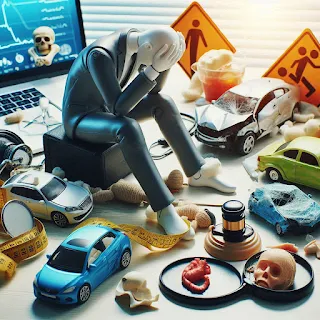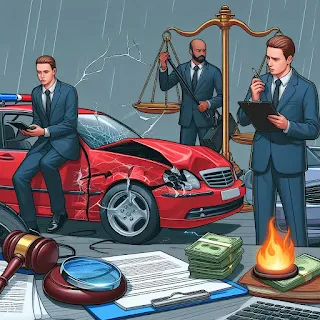Car accidents are unfortunately a regular part of life in the United States, with over six million crashes occurring annually, as reported by the National Highway Traffic Safety Administration (NHTSA). While many accidents are minor, others result in severe injuries that can impact individuals for years or even a lifetime. For young drivers between the ages of 18 and 35, it’s crucial to understand the types of injuries that can occur in car accidents, how they happen, and the long-term effects they might have on one’s health, as well as their legal rights.
This article delves into the most common injuries caused by traffic accidents in the U.S., offering an in-depth look at the physical, emotional, and legal impacts these injuries can have. It also provides insight into how to protect yourself legally if you are involved in an accident and what steps to take to ensure that you are properly compensated for your injuries.
1. Whiplash: A Common and Painful Injury
One of the most common injuries in car accidents is whiplash, a neck injury that occurs when the head is suddenly and forcefully jerked forward and backward, often in rear-end collisions. While it’s more common in low-speed accidents, whiplash can happen in crashes of any severity. This injury can cause severe neck pain, headaches, dizziness, and sometimes even long-term complications if not treated properly.
Symptoms of Whiplash
- Neck pain and stiffness
- Headaches, usually starting at the base of the skull
- Dizziness or vertigo
- Pain in the shoulders or upper back
- Limited range of motion in the neck
- Fatigue and difficulty sleeping
Whiplash can sometimes be difficult to diagnose, as it doesn’t always show up in standard medical imaging, such as X-rays or MRIs. As a result, individuals experiencing whiplash may find it challenging to prove the extent of their injuries, which is why it’s essential to consult with a medical professional for an accurate diagnosis and treatment plan.
Legal Considerations
For those seeking compensation for whiplash injuries, it’s important to keep thorough records of medical treatments, including doctor’s visits, physical therapy, and any diagnostic tests. A lawyer experienced in accident claims can help ensure that you are properly compensated for medical bills, lost wages, and pain and suffering.
2. Broken Bones and Fractures
Another common injury in car accidents is broken bones. The force of a collision can cause fractures in various parts of the body, including the arms, legs, ribs, and pelvis. Depending on the severity of the crash, some fractures can be compound (bone breaks through the skin), while others may be simple (a clean break without skin penetration).
Types of Bone Fractures
- Closed Fractures: The bone is broken, but the skin is not punctured.
- Open (Compound) Fractures: The bone breaks through the skin, leading to higher risk of infection.
- Stress Fractures: A small crack in the bone caused by repetitive force or pressure, which may develop over time due to a collision.
Fractures may require a cast, surgery, or extensive rehabilitation to heal properly. In severe cases, broken bones can lead to long-term complications, including permanent disability or limited mobility.
Legal Considerations
When filing an insurance claim or seeking legal compensation for broken bones, it’s crucial to document the full extent of the injury, the medical treatments required (such as surgery, physical therapy, or rehabilitation), and the time lost from work. A personal injury lawyer can help guide you through the process of securing appropriate compensation for medical expenses, lost wages, and other damages.
3. Traumatic Brain Injuries (TBI)
Traumatic brain injuries (TBIs) are among the most serious injuries that can result from car accidents. TBIs occur when the brain is injured due to a sudden impact, such as a blow to the head during a collision or the brain moving within the skull during the crash. Even mild TBIs, such as concussions, can lead to significant long-term consequences.
Symptoms of TBI
- Loss of consciousness
- Memory problems
- Difficulty concentrating or thinking clearly
- Persistent headaches
- Dizziness or lightheadedness
- Mood swings, anxiety, or depression
TBIs can be difficult to detect, and symptoms may not appear immediately after the accident. A person involved in a car accident might feel fine at first but later experience cognitive problems, fatigue, or emotional changes. For this reason, anyone who sustains a blow to the head should seek immediate medical attention.
Legal Considerations
Because TBIs can have lasting consequences, seeking compensation for a brain injury is a serious legal matter. You may be entitled to compensation for medical bills, rehabilitation costs, lost earning potential, and even non-economic damages such as pain and suffering. Working with an experienced lawyer who understands the complexities of TBI claims is vital for protecting your future.
 |
| Image generated with the assistance of Copilot AI |
4. Spinal Cord Injuries
Spinal cord injuries are among the most catastrophic consequences of car accidents. These injuries can result in partial or complete paralysis, depending on the location and severity of the injury. A spinal cord injury can cause life-changing consequences, often requiring ongoing medical care, physical therapy, and home modifications.
Symptoms of Spinal Cord Injuries
- Loss of movement or sensation in any part of the body
- Numbness, tingling, or weakness in the limbs
- Difficulty breathing or loss of control over bodily functions
- Severe back pain or pressure
Spinal cord injuries typically occur in high-impact accidents, particularly those involving collisions at high speeds, rollovers, or large commercial vehicles. Even a minor injury to the spinal cord can have serious repercussions, as nerves may be damaged, leading to permanent disability.
Legal Considerations
If you suffer a spinal cord injury due to a car accident, the financial burden of medical treatments and rehabilitation can be overwhelming. Legal compensation can help alleviate these costs. Depending on the severity of the injury, compensation may cover ongoing medical care, physical therapy, long-term disability, and home care needs.
5. Internal Injuries
Car accidents can also cause a variety of internal injuries, which are sometimes not immediately visible. Internal injuries can affect organs such as the liver, spleen, kidneys, or lungs. These injuries can be particularly dangerous because they may not show symptoms right away, making them harder to diagnose in the early stages.
Common Types of Internal Injuries
- Hemorrhaging: Internal bleeding caused by broken ribs or trauma to internal organs.
- Organ Damage: Damage to organs such as the liver, spleen, or kidneys, often resulting from direct impact or blunt force trauma.
- Pneumothorax: A collapsed lung caused by a rib fracture or trauma to the chest.
If you experience sudden abdominal pain, chest pain, or difficulty breathing after an accident, it’s essential to seek medical attention immediately.
Legal Considerations
Since internal injuries may not be immediately visible, having a thorough medical examination following a car accident is critical. If you experience complications or long-term effects from internal injuries, legal action may be required to ensure that you are properly compensated for your medical bills, lost wages, and pain and suffering.
6. Psychological Injuries
While physical injuries are the most immediate concern after a car accident, psychological trauma is also a significant consequence that many victims face. This can include conditions such as post-traumatic stress disorder (PTSD), anxiety, and depression. For young drivers who are not used to the stress of accidents, the emotional impact can be just as significant as physical injuries.
Symptoms of Psychological Injuries
- Flashbacks or nightmares related to the accident
- Difficulty sleeping or staying calm
- Increased anxiety or depression
- Avoidance of driving or car-related situations
Many accident victims struggle to adjust to the emotional aftermath of a crash, which can interfere with their daily lives and relationships.
Legal Considerations
If you experience psychological trauma after an accident, you may be able to seek compensation for mental health treatments, therapy sessions, and the emotional toll the accident has taken on your life. It’s important to consult with a mental health professional and document the psychological effects of the crash for use in any legal proceedings.
7. Conclusion
The injuries caused by car accidents can vary greatly in severity and impact. Whether you’ve experienced whiplash, a broken bone, a traumatic brain injury, or even psychological trauma, it’s crucial to understand the nature of your injuries and how to take the right legal steps to protect yourself. Consulting with a doctor immediately after an accident is essential for your health, while seeking legal assistance can help ensure you receive the compensation you deserve for both your physical and emotional recovery.
By understanding the common injuries caused by traffic accidents and knowing the appropriate actions to take, young drivers can be better prepared to navigate the challenges that come after an accident.
Sources:
National Highway Traffic Safety Administration (NHTSA) – https://www.nhtsa.gov
NHTSA provides valuable resources on traffic accident statistics and injury prevention strategies.Mayo Clinic – https://www.mayoclinic.org
Mayo Clinic offers expert medical advice on whiplash, brain injuries, and spinal cord damage.American Spinal Injury Association (ASIA) – https://www.asia-spinalinjury.org
ASIA offers resources on spinal cord injuries and how they impact victims.American Psychological Association (APA) – https://www.apa.org
APA provides information on the psychological impact of car accidents, including PTSD and anxiety.

















.jpeg)
